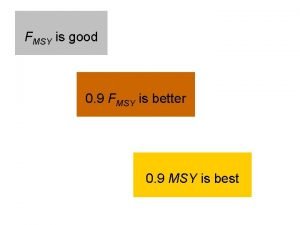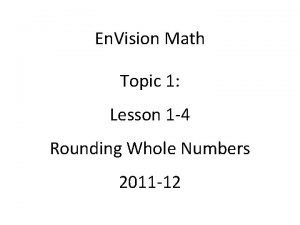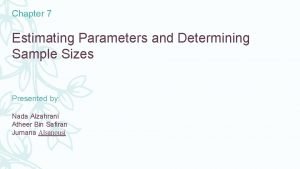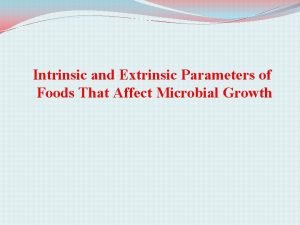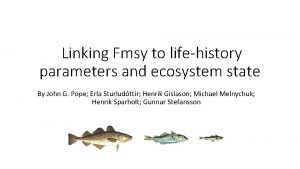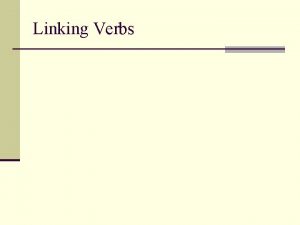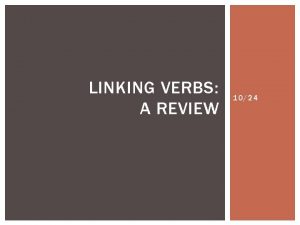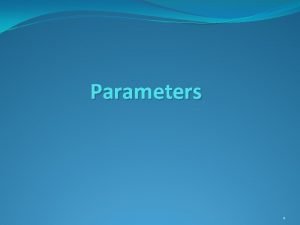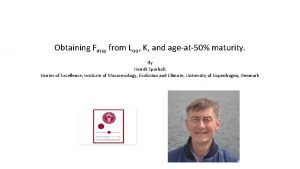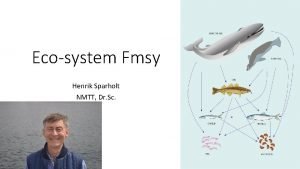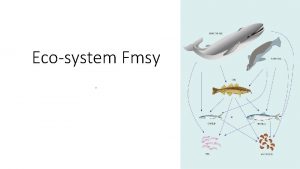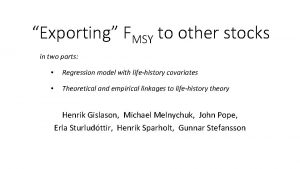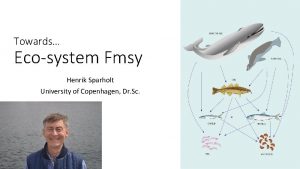Q 493 Linking Fmsy to lifehistory parameters and













- Slides: 13

Q: 493 Linking Fmsy to life-history parameters and ecosystem state By. John G. Pope; Erla Sturludóttir; Henrik Gislason; Michael Melnychuk; Henrik Sparholt; Gunnar Stefansson

The Problem • Multispecies Models suggest that Single Species Fmsy’s are often low. • For Example - Pope et al. 2018 fitted 4 multispecies models to North Sea, 3 to Baltic and 2 to Icelandic fish stocks. • Over all these models -Increasing fishing mortality on a species would increase its yield in 78% of cases. • However, they also find inter-model variation in predicted yield. • So SS models are Biased but MS models are Variable. • Life history parameters have a long history in MSY studies. • Could linking life history parameters to the ecosystem state help?

Some Clues: Coexistence and the scaling of recruitment (Pope et al. (2006) and Hall et al. (2006) ) • Their size-based multispecies models of the North Sea and Georges Bank found for Coexistence, recruitment had to scale with L∞ to powers of -3. 5 or -2. 5, or only the largest species would persist • While Denney et al. 2002’s data analysis found Max. no. of recruits per kg spawner at low levels of spawning stock biomass scaled as L∞ to the power of -3. 0 • In seasonal seas this scaling seems unlikely to be due to differences in fecundity!

Why- If fecundity were the answer haddock would have to produce 8 and Norway pout more eggs per kg than cod. So how else can a three order difference in the maximum number of recruits per kg spawner be explained? 200

Natural Mortality that increases with L∞ seems a plausible cause for recruitment scaling with L∞ • The natural mortality after settling has been reported to scale with L∞ (Pauly 1980) as well as with individual length, L (Mc. Gurk 1986, Lorentzen 1996): • This suggests – • Where i is positive and n negative. • I. e. M gets smaller with Length for all species • But bigger species have higher M at same length

Henrik Gislason lead various published theoretical and empirical studies of this relationship • That eventually lead to the Charnov, Gislason and Pope (2013) equation • M=K*(L∞ /L)^1. 5 • This equation is justified both by regression of data from low F stocks and from coexistence calculations with F=0

However, this equation is calculated for Fishing Mortality that was zero or low. • But multispecies models and size spectrum theory both suggest that • M would scale with increasingly negative powers of L as fishing mortality increases • Put simply we would expect M to get smaller with size when the larger fish that cause it have been fished down.

This Suggests Changes to M=K*(L∞ /L)^1. 5 More generally we could see the equation in 3 parts. • M= Prefactor(F)* (K* L∞ 1. 5 )*L-Power(F) • So both the Prefactor and the Power of L are functions of F and (K* L∞ 1. 5 ) is a suitability term. • And the Power of Length gets more negative as F increases

Using Gislason’s coexistence calculation • While keeping the same suitability term of K*(L∞)^1. 5 • At different levels of Fishing Mortality Rate we find. • Note the prefactor gets smaller and the Power of L More negative as F gets bigger.

We can also make a version of the Pope et al 2006 model with suitability that follows this rule. Using this M get lower as F get bigger. Figure shows results for L∞ =130 cm. Other L∞’s match this at lower levels Note M gets smaller quicker as F gets bigger.

It is easy enough to calculate Yield per recruit with such a formula for M for different powers of L. But the question remains. How to link the Prefactor and Power of L to Fishing Mortality?

So How to go forward to Fmsy? Size Spectrum theory suggests • M scales as L^(Constant+β) where β is the (-ve) slope of the regression of the size spectrum of ln numbers on ln length. • Models show β gets more negative as F increases. • Moreover models suggests β change only slowly as F changes. • Thus the observed spectra from surveys could be used to estimate the current Prefactor and L power and these should persist for a while. • Such an approach to estimating M and hence Fmsy might be less biased than single species models and be less variable than Multispecies Models. • But how best to do this is a work in progress!

• Thanks • That’s All Folks
 Fmsy
Fmsy Henrik sparholt
Henrik sparholt Static vs dynamic linking
Static vs dynamic linking Hymn 493
Hymn 493 647 song
647 song Round 493 295 to the nearest ten thousand
Round 493 295 to the nearest ten thousand 160 656 rounded
160 656 rounded Round 138 to the nearest ten
Round 138 to the nearest ten Transitive intransitive and linking verbs
Transitive intransitive and linking verbs Unit 7 lesson 2 parameters and return investigate
Unit 7 lesson 2 parameters and return investigate Lesson 3 parameters and return practice
Lesson 3 parameters and return practice What is the point estimate of μ?
What is the point estimate of μ? Lesson 3 parameters and return practice 7
Lesson 3 parameters and return practice 7 Intrinsic and extrinsic parameters of food
Intrinsic and extrinsic parameters of food
